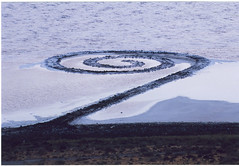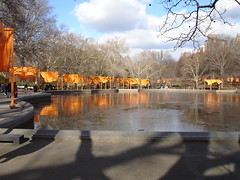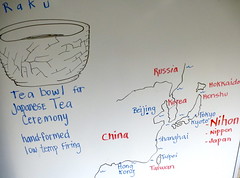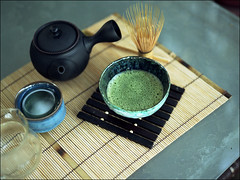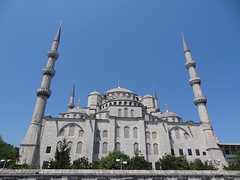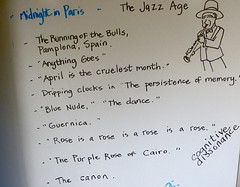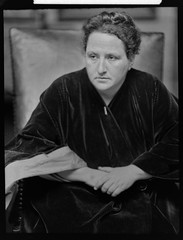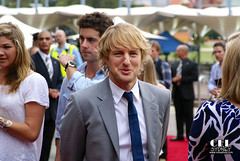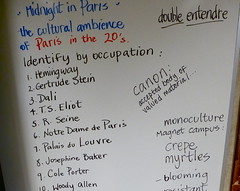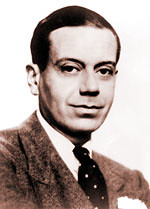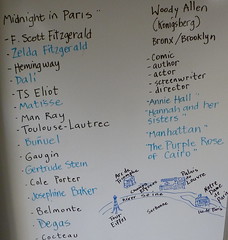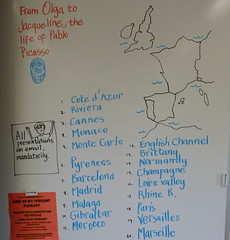The FAS semester exam will comprise
a) 50 multiple-choice questions taken from quizzes posted on the class blog. An open-notes test, some of the questions will have been tweaked to add an element of rigor to this test of reading comprehension.
Answered and scored on Scantron forms.
b) Brief comparison essay of any two not-ordinarily-relatable topics. Examples:
- Basquiat and Bas relief sculpture.
- Espresso and the Pantheon.
- Greek alphabet and Diego Rivera.
- Frida Kahlo and the Parthenon.
If you have a comparison essay question, ask my approval during class - write it in your notebook and I will initial it - or via email.
The rubric (required elements) that will guide essay writing:
1. Colorful opening. There are 3 recommended ways to create an interest-getting opening: a) use a quote b) ask a question c) write with vivid description.
2. Blend the topics continually in the paper. Do not write a block of material about one topic and then write a separate block about the other topic. Integrate the topics as you offer insight and evidence.
3) Use comparison terms:
* different from,
* the same,
* both,
* similar to,
* Neither, ... nor,
* like X is (adjective),
* ... than X is (adverb) than.
* both, ...
* either...or
* likewise
* similarly
* although,
* but neither...
* nor
* however
* on the other hand
4. Specific examples must be used to support generalities. An example: generality - The Incredibles was an awesome movie. specific - The Incredibles appealed to me because the characters (especially the mom and the teen sister) were believeable. They sounded like people I know.
5. Grammar counts.
6. Spelling, too. When in doubt, see a dictionary or ask me.
7. Punctuation is paramount. Again, ask me or your Grammar Check software.
8. Include documentation via "according to ...". This means include your source - from World Book to your little brother - in the body of your writing. Usually you place it at the end of the first or second sentence, says Grammar For Today.
9. Write a snappy title. Ways to make a title fun are to tweak a song or movie title or use alliteration. Also, write an explanatory subtitle. Example: "Dinkas are Incredibles;" "Many refugees from the Sudanese Dinka tribe have moved from poverty in east Africa to comfort in the US."
Finally, please don't put quotation marks around your title - unless you are quoting someone.
Habanero and hola! quiz
1. The monumental art form created by indigenous peoples in Mexico: a) cities surrounded by water b) cities carved into rocky promontories c) pyramids.
2. Diego Rivera was a Mexican artist whose peak of fame was in the 1950's. He worked in buildings in the US, Europe and Mexico. His principal art format was probably the a) mural b) tapestry c) relief painting d) sculpture.
3. Name 2 indigenous (native) peoples of Mexico. a) Toltec b) Aryan c) Inca
d) Tartars e) Maya d) Hasinai.
4. Two food resources that originate in Mexico. a) chili peppers b) black pepper c) cacao bean d) vanilla bean e) sugar cane f) barley.
5. Mexico is surrounded by an ocean and 2 seas: __, __ _ ___, __ .
6. The capital city of Mexico: a) Guadalajara b) Monterrey c) Mexico, DF.
7. When you think of El Chicos and Trejo's the term "Mexican food" is not quite the most accurate designation. How should their cooking be classified?
8. Mexico-born and raised actress: a) Salma Hayek b) Annette Benning c) Cate Blanchett d) Meryl Streep.
1. pyramids in both the Yucatan Peninsula and central Mexico. 2. murals and frescoes.
3. Toltec, Aztec, Olmec, Maya. 4. chili pepper, cacao bean, vanilla bean.
5. Pacific, Gulf of Mexico, Caribbean. 6. Mexico, Distrito Federale. 7. Tex-Mex, a hybrid. 8. Salma Hayek.
Mandatory map of Mexico
1. Peninsula on the Pacific coast: __ __.
2. Resort at tip of peninsula on the Pacific / Gulf of California. __ _ __ .
3. Peninsula on the Gulf of Mexico / Caribbean. __
4. Resort island on the Caribbean coast: __ .
5. Resort on the Pacific mainland famous for cliff divers and honeymoon suites: __ .
6. Border town across from San Diego: __ .
7. Border town across from El Ppaso: __ __ .
8. Western mountain range: __ __ __ .
9. Eastern mtn. range __ __ __ .
10. Population of Mexico City: a) 5 M b) 10M c) 22M.
Manhattan's most famous sections. Commit to memory, please.
1. Center of jazz history and Afr-Amer culture: __ .
2. Notable institution in Morningside Heights and Harlem: ____ Univ.
3. Upper ___ Side (Madonna, John Lennon, other rich & powerfuls)
4. Upper ____ Side (more of the wealthy class)
5. Broadway theater district and Carnegie Hall are in __ .
6. Art, shopping, high-tech, gay life in a neighborhood above the Village: __ .
7. Oldest historic neighborhood; once cheap housing for bohemians, today gentrified: __ __ .
8. Hip downtown music & art scene - "Rent" was set here: __ __ .
9. Center for impoverished immigrants (once dminated by Jews); today undergoing gentrification: __ __ __ .
10. Historic art, shopping, restaurants South of Houston St: __ . Think London.
11. Chinese immigrants' shops and restaurants in lower Manhattan: __ .
12. Fashionable historic warehouse district in a "Triangle below Canal St:" __ .
13. Lower Manhattan: __ __ financial district and site of the __ __ __ from 1973 to 2001.
14. River on the east side of Manhattan Is: __ River.
15. River on the west side of Manhattan Is: __ River.
16. Borough directly east of Lower Manhattan: __ .
17. Borough on the mainland north of Manhattan: the __ .
18. State west of NYC and south of NY state: __ .
19. State on Long Island Sound, northeast of NY and NYC : __ .
20. Process of refurbushing and upgrading old and run-down buidings and neighborhoods: ___ .
21. Harlem's classification: a) neighborhood b) borough.
1. Basquiat lived about __ years.
2. As a graffiti artist, Basquiat / SAMO focused on __ rather than stylishly painted logos.
3. As a developing artist, Basquiat lived in Manhattan on the __ __ __, a neighborhood where impoverished creative types flourished in the late 70's and 80's.
4. Oldest historic residential area of Manhattan.
5. Residences of the moguls in Manhattan.
6. Section of Manhattan where you'll find Carnegie Hall and the Plaza Hotel.
7. University adjacent to Greenwich Village
8. Process of upgrading old and run-down buidings and neighborhoods.
9. Most southerly borough of NYC.
10. Famous Manhattan neighborhood adjacent to the Bronx.
11. Peninsula on the Gulf of Mexico / Caribbean
The East Village quiz
1. In his art, it is said that Basquiat used "appropriation." Another word for appropriation would be a) stealing b) inspiration c) raunchiness d) bold color.
2. Basquiat was amoral and ahistorical, being a superbly contemporary thinker. T / F
3. "Genius Child" is a poem by a) Maya Angelou b) Lorraine Hansberry c) Zora Neal Hurston d) Langston Hughes.
4. The med school classic, Gray's Anatomy, has origins in 19th century a) Germany b) England c) America d) France.
5. In 1981 Basquiat painted one of his most-analyzed works, "Irony of Negro __."
6. Basquiat spoke Creole, among several languages, because his father was from the impoverished Caribbean island of __ .
7. Word that means not transparent or translucent: __ .
8. Word that means to provoke, to interest, to prick: to __ .
Sculpture quiz
1. Sculpture that is attached to the background but raised above the background in a moderate way has a name that includes a French term: __ __ .
2. "For sculpting you may bring a __, aka a writing utensil, a small tool for marking or shaping, for example in pottery." Think of a Latin word for a writing pen.
3. The Venus of Willendorf: found in 1908 in the nation of __ .
4. The Venus of Willendorf: was tinted the color __ .
5. Scholars feel that the name "Venus of Willendorf" is a) descriptive b) ethnocentric c) has widespread appeal d) evocative of classical history.
6. Statues, coins, drawings, pendants or rings carried on a person to repel evil: __ .
7. This revolutionary Pharaoh, today known as the father of Tutankhamun as well as husband of Nefertitti, radically changed Egyptian art, architecture and religion: __ . Spell the name correctly, please.
8. High above the city of Athens is a temple dedicated to a woman. What is the name of the elevated mesa upon which the temple stands? __ .
Historic sculpture quiz
1. Sculpture that is attached to the background but raised above the background in a moderate way has a name that includes a French term: __ __ .
2. "For sculpting you may bring a __, aka a writing utensil, a small tool for marking or shaping, for example in pottery." Think of a Latin word for a writing pen.
3. The Venus of Willendorf: found in 1908 in the nation of __ .
4. The Venus of Willendorf: was tinted the color __ .
5. Scholars feel that the name "Venus of Willendorf" is a) descriptive b) ethnocentric c) has widespread appeal d) evocative of classical history.
6. Statues, coins, drawings, pendants or rings carried on a person to repel evil: __ .
7. This revolutionary Pharaoh, today known as the father of Tutankhamun as well as husband of Nefertitti, radically changed Egyptian art and architecture: __ . Spelled correctly, please.
8. High above the city of Athens is a temple dedicated to a woman. What is the name of the elevated mesa upon which the temple stands? __ .
Parthenon:
- pediment
- bas relief sculpture
- doric columns
- capitals
- flutes
- statue of Athena
- frieze
- Greek key
- Bust of Pericles, 450 BCE
- Under the Parthenon add a representation of the acropolis.
Identify Espana, L'Italia, Graecia, Aegypticus, Maroc and Carthage.
Discovering Art History: pp 172 - 190.
1. The Cretan civilization is called the Minoan for their a) king b) queen c) soothsayer d) bull / king.
2. Early civilizations in the Aegean existed simultaneously with the Mesopotamian and Egyptian cultures. See chapter 5 to compare timelines. T / F
3. Mesopotamia ("land between the rivers") was today's a) Iran b) Iraq c) Saudi Arabia d) Lebanon.
4. Mycenae was, along with Olympia and Sparta, located on the Peloponnesus __.
a) island b) peninsula c) isthmus d) sea.
5. Minoan civilization was first known through Homer's a) Odyssey b) Iliad
c) Cyclops d) Trojan War.
6. A painting made of lines and colors applied to wet plaster is called a __ .
7. A study of the Palace of Minos at Knossos implies that Cretans were oriented toward a) trade b) war c) austerity.
8. Bull leaping can also be called bull- __. It's a word that refers to heights.
9. Sketch a representation of the a) Octopus jar and b) the Funeral mask. Label the cultures they represent.
Aegean quiz
1. The Peloponnesus has four notable locations: Corinth (and the Isthmus of Corinth), Olympia, Mycenaea and __.
2. The blind author whose focus was the Aegean: __ .
3. A __ is a type of painting made of lines and colors applied to wet plaster.
4. Bull vaulting is most famously associated with the nation of __ .
5. Simultaneity in the Mediterranean and Persian Gulf regions: Cretan, Mycenean, ____ and Egyptian cultures.
6. In the famous regional name which means "land between the rivers," which part of the name means "between"? __
7. The golden age of Crete is known as the __ civilization.
8. Typical of Mediterranean cultures, the Cretans reserved the rite of bull-vaulting for males. T / F 1. sparta 2. homer 3. fresco 4. crete 5. mesopotamian 6. meso 7. minoan 8. f
Greek alphabet
1. Looks like an upside-down V: __ .
2. A letter O with a horizontal bar in the center: __ .
3. The letter shape for Beta: __ .
4. The name for the empty O: __ .
5. The symbol for Pi: __ .
6. The unexpected symbol for Rho: __ .
7. First and last letters of the Gk alphabet: __ and __ .
8. Unexpected symbol for Eta: __ .
9. Sound that a cat utters: __ .
10. A hangman's frame: __ .
11. I'm za Sigma! __ .
12. Chi, pronounced Kye, has the shape of an __ .
13. The capital Y letter is an __ .
14. A capital I with "wings:" __ .
15. Three horizontal bars: __ .
16. "Oh, you're Nu here!" __ .
17. There's a tiny town in middle-of-nowhere Louisiana named Iota. __ .
18. I Eta Pi: __, __ .
19. Rock 'n roll is based largely on Delta blues. __ .
20. Taurus, the bull, shortened to T: __ .
21. Omicron my Gawd: __ .
22. It's raining. Put on your K: __ .
23. I got an advance look at that software; I'm a __ tester.
24. E! Magazine: __ .
25. National math honorary society, and active at Magnet: __ __ __ .
26. University-level honorary society that expects proof of consistently high ethics and grades to qualify: __ __ __ .
27. The lower-case version of this letter looks like a lower-case a: __ .
28. Third letter: __ .
29. The Epsilon was derived from Phoenician writing. T / F .
30. Symbol for the Earth. Also seen in the Celtic cross. Yet, sometimes a symbol for death: "thanatos." __ .
31. The lower-case fo0r this letter looks like a capital E in script: __ .
32. This Greek letter is rarely used in math, because it so ambiguous: __ .
33. Neptune and water; the S sound: __ .
34. A mathematical constant that is the ratio of a circle's circumference to its diameter: __ .
35. In math, art and literature, the Golden Ratio, or 1.61: __ .
36. The gigantic letter O: __ .
37. The tiny letter O: __ .
38. _ is often used to abbreviate the name Christ, as in the holiday Christmas.
39. The 14th of March (3.14. 2012) is widely celebrated as __ Day.
40. Used to refer to the lowest-ranked wolf in a pack or the least-powerful person in a group: __ .
41. X plus __ represents the person of Jesus Christ, or Chi Rho.
42. "Jeez, I wish that organization would name me as a pledge. Sigh!" __
43. The Black Gangster Disciple Nation, or the GD's, uses the trident symbol, or : __ .
44. In ancient times, __ was used as a symbol for life and/or resurrection. It is a form of the cross.
45. Cornell Univ, Ithaca, NY, was the site of the first black fraternity, Alpha Phi Alpha, 1906. Washington, DC's Howard University, 1912, was the site of the founding of the first black Greek sorority: __ __ __ .
Teotihuacan is the city of stone pyramids which is outside of today's Mexico City.
Attica is the region around Athens.
1. Stone pyramids were created by indigenous peoples in the Baja peninsula as well as the Yucatan Peninsula of Mexico. T / F False: there are none in the Baja.
2. The best-known of all Mexican artists is not Frida Kahlo. It is the muralist Diego Rivera.
3. Indigenous peoples of Mexico: the Olmecs, Toltecs, Aztecs and the _Mayans .
4. Black pepper, along with the vanilla bean and cacao bean, are foods that originate in Mexico. T / F False: Black pepper is from Asia. Chili peppers are Central American.
5. Mexico has a _Caribbean_ coastline as well as one on the Pacific and Gulf of Mexico.
6. Mexico's eastern mountain range: _Sierra Madre Oriental_ .
7. The most notable street in Lower Manhattan: _Wall_ .
8. Carnegie Hall and the Plaza Hotel are in _midtown_ Manhattan.
9. To the east of Columbia Univ is the borough called _the Bronx_ .
10. Impecunious Chinese, Jews and Italians historically settled in the _Lower East Side_ of Manhattan.
11. In his early career Basquiat was as much an aficionado of images, a designer, as a graffiti artist. False: he was a poet, not designer.
12. Part of Basquiat's success was due to his location: a) Manhattan b) Brooklyn c) Harlem d) SoHo. Born in B'lyn, he flourished in lower Manhattan, A).
13. If Basquiat had wanted to attend college, it would have been easiest for him to enroll at _NYU_. NYU is part of Lower Manhattan.
14. West of the Bronx is a famous Manhattan neighborhood called _Harlem_ .
15. Basquiat constantly used famous pieces of art as a basis for his paintings. That sort of taking of ideas is called _appropriation_ in the art world.
16. Basquiat loved a kind of jazz that was not popular in the 1980's: a) cool jazz b) bebop c) hip hop d) Dixieland. B) Dizzy Gillespie, etc; bebop.
17. Langston Hughes wrote a poem that seemed to apply very well to Basquiat. It is called " _Genius Child_ ."
18. As a child confined to a the hospital bed Basquiat's mother bought him a copy of a med school text: _Gray's Anatomy_ .
19. Basquiat spoke French, Spanish and _Creole_ , among several languages, because his father was from Haiti .
20. Opaque means not _translucent_ .
21. Incised sculpture is raised above the background to a moderate, not extreme, height. T / False: incised means "cut into."
22. Austria has a small town famous for a sculpture that has been given the Roman title of a __ . Roman title: a Venus.
23. Lockets or other small objects meant to insure safety: __ . amulets or talismans.
24. Akhenaten upset Egyptian art, architecture and religion. One of his many sons was known as _Tutankhamun_ .
25. An exquisite, realistic bust of Queen _Nefertiti_ is part of the legacy of the pharaoh known as Akhenaten.
26. Athens has a fortified district known as the _acropolis_ .
27. Cretans of the earliest era are referred to as _Minoans_.
28. Lesbos and Santorini are in the _Aegean_ Sea.
29. Mesopotamia, the "land between the rivers," is today's a) Iraq b) Saudi Arabia c) Lebanon d) Iran. A) Iraq. Since the US invasion of Iraq, US soldiers have fought and died on the banks of Mesopotamia.
30. Corinth, Olympia and Sparta have a location in common: the _Peloponnesus_ .
31. Homer's Iliad refers to the __ culture. a) Greek b) Turkish c) Minoan d) Mycenaean. c) Life on the isle of Crete.
32. A fresco is created via wet _plaster_ .
33. Minoans were the first Western peoples to build large structures called _palaces_ .
34. The Minoan preceded the Greek which preceded the Egyptian but followed the Phoenician. T / False: ridiculous.
35. Female equality of some degree was seen in the poetic endeavors of people on the isle of _Lesvos or Lesbos_ .
36. A letter O with a horizontal bar in the center: _theta_ .
37. A small table is the symbol for the Greek letter _Pi_ .
38. The symbol for Eta: _H_ .
39. A capital I integrated into a wine glass: _Psi_ .
40. Fraternity which requests membership of the elite: _Phi Beta Kappa, the national honorary society for high grades and ethics_ .
Temple of Seven Gods: the original Pantheon
1. Granite columns of the __ style.
2. It has the world's largest, unreinforced __ dome.
3. Columns were quarried in the nation of __ .
4. The __ __ sculpture originally installed in the pediment was lost ages ago.
5. The drum of the building surrounds a room called the __ .
6. The oculus on the roof is matched by a __ in the marble floor.
7. The height and diameter of the interior are __ in proportion.
8. The horizontal space above the capitals and below the pediment is called the __ ; it contains the name Marcus Agrippa.
9. It was rebuilt and dedicated to Agrippa by the Emperor __ .
10. Agrippa's military success, acc to Wikipedia, was connected with the death of one of the most famous rulers of Egypt: __ .
11. Sunken panels called __ decorate and strengthen the dome.
12. The Greek letter of the Golden ratio, 1.61, is widely used in math, art and architecture: __ .
13. The Greek letter which refers to the ratio of a circle's circumference to its diameter: __ .
14. The language of the ancient Lebanese, or __, was the father to the Greek language.
15. In the European world the Greek alphabet was succeeded by the __ alphabet.
16. In 3 sentences describe the impressive features of the Pantheon as well as the influence of the temple's design.
Roman buildings
1. atrium - a large open space within a building - sometimes with a glass roof.
2. villa
3. insulae, or apartment blocks
4. vineyards
5. arbors
6. Roman tiles
7. Roman arch
8. mosaics
9. frescoes
10. peristyle - covered walk around a garden.
Qahwah Quiz
1. Coffee was developed by people in SW Asia on the __ Peninsula.
2. The coffee bean originated in NW Africa in the nation of __ .
3. The ___ and the Spectator, London news and gossip publications of the 18th century, were written by men who spent long hours in coffee houses.
4. Coffee developed within the long history and ample territory of the Ottoman Empire. The Ottomans ruled the Mid east from the nation of __ .
5. The European nation best known for the development of coffee is __ .
6. A once-independent city-state that facilitated the trade between Europe and the Middle East. It was a point for importing coffee culture into Western Europe: __ .
7. Coffee was sanctioned by two religions: __ and Islam.
8. Smoke from a huqqa is made cooler by the fine droplets of moisture vacuumed from the vase along with the smoke. T / F
Picasso quiz
1. Picasso was born in the Spanish city of a) Malaga b) Coruna c) Madrid d) Barcelona.
2. He became an accomplished painter as a teen. T / F
3. He was from a notable region of Spain called a) Basque b) Alsace
c) Catalonia d) Andalusia.
4. Picasso's most-loved sport: a) futbol b) handball c) mountain hiking d) bull fights.
5. He was born in poverty but was enormously successful as a painter. T / F
6. Picasso's Big Apple was a) Paris b) Madrid c) NYC d) London.
7. Picasso belonged to the group of European artists who called themselves the surrealists. T / F
8. Picasso was a member of the group of European artists who called themselves the fauvists (French: "savages"). T / F
9. Picasso was a member of the group of European artists who called themselves the cubists. T / F
10. He felt most at home in the Spanish city where he spent his teens: a) Malaga b) Coruna c) Madrid d) Barcelona.
11. This Spanish painter touched Picasso more than the others:
a) El Greco b) Goya c) Velazquez d) Dali.
12. His lifelong friend and rival was the almost-equally famous painter a) Henri Matisse b) Salvador Dali c) Vincent Van Gogh d) Jean Renoir.
13. The Blue Period and the Rose Period paintings were part of his __ career. a) early b) late.
14. Picasso and other artists favored life in the __ section of Paris in the early 1900's. a) Montmartre b) Bastille c) Champs d'Elysees d) St Germain.
15. The famous river that flows through the heart of Paris: the __ .
a) Loire b) Thames c) Rhine d) Seine.
16. Two of the faces in Demoiselles d'Avignon reflected Picasso's interest in the masks and sculptural art of the continent of __ .
a) Asia b) Africa c) Eastern Europe d) South America.
17. One of Picasso's earliest Parisian lovers, Eva Gouel / Marcelle Humbert, died of __ . a) illness / cancer b) suicide c) murder d) motorcycle crash.
18. For half of his adult life Picasso was married to the former Russian ballerina, __ __. a) Olga Kohkalova b) Marie-Therese Walter
c) Dora Maar d) Francoise Gilot.
19. Claude and Paloma Picasso were the children born to the artist and mistress __ __ . a) Olga Kohkalova b) Marie-Therese Walter c) Dora Maar d) Francoise Gilot.
20. During WWII the city of Paris was occupied by the __ .
a) Russians b) English c) Germans d) Dutch.
21. The painting "Guernica" depicts the bombing of a Spanish village by German bombers in 1937, during the ____ . a) WWI b) WWII c) Spanish Civil War d) Spanish-American War.
22. The painting "Demoiselles d'Avignon" portrays a) French dancers
b) Spanish prostitutes c) African laundry workers d) the five muses.
Cranial quiz
1. The brain case: the __ .
2. The somewhat triangular shoulder blade: a) scapula b) sternum c) mandible d) femur.
3. The collar bone: ___ . a) patella b) clavicle c) mandible d) femur.
4. The bone that supports your biceps: __ . a) mandible b) fibula c) femur d) humerus.
5. The radius and ulna are associated with your a) neck b) spine c) shin d) forearm.
6. The phalanx bones are part of your a) legs and arms b) hands and feet c) vertebrae and cranium d) ribs and pelvis.
7. The tarsus is associated with the __ . a) foot b) hand c) neck d) pelvis.
8. The pair of bones that comprise your shins: __ . a) tibia and fibula b) ulna and radius c) carpal and metacarpal d) humerus and radius.
9. The vertabrae are connected to the __ . a) mandible b) ribs c) pelvis d) ulna.
10. Your tailbone, or coccyx, is part of the a) os coxae b) carpals c) cranium d) calliope.
Thursday, November 29, 2012
Land art: the 1970 Great Salt Lake sculpture called Spiral Jetty
Spiral Jetty is an earthwork sculpture constructed in 1970 by American sculptor Robert Smithson, says Wikipedia.
Built on the northeastern shore of the Great Salt Lake near Rozel Point in Utah entirely of mud, salt crystals, basalt rocks and water, Spiral Jetty forms a 1,500-foot-long (460 m), 15-foot-wide (4.6 m) counterclockwise coil jutting from the shore of the lake.
The water level of the lake varies with precipitation in the mountains surrounding the area, revealing the jetty in times of drought and submerging it during times of normal precipitation.
Originally black basalt rock against ruddy water, Spiral Jetty is now largely white against pink due to salt encrustation.
Please see more at Land Art, Environmental art, Site-specific art and Sustainable art.
Built on the northeastern shore of the Great Salt Lake near Rozel Point in Utah entirely of mud, salt crystals, basalt rocks and water, Spiral Jetty forms a 1,500-foot-long (460 m), 15-foot-wide (4.6 m) counterclockwise coil jutting from the shore of the lake.
The water level of the lake varies with precipitation in the mountains surrounding the area, revealing the jetty in times of drought and submerging it during times of normal precipitation.
Originally black basalt rock against ruddy water, Spiral Jetty is now largely white against pink due to salt encrustation.
Please see more at Land Art, Environmental art, Site-specific art and Sustainable art.
Wednesday, November 28, 2012
Christo's 10-year, 2-week, $20 million art project: The Gates, 2005
Christo (born Christo Vladimirov Javacheff, Bulgarian,1935) and Jeanne-Claude (1935 – 2009) were a married couple who created environmental works of art, says Wikipedia.
Their works include the wrapping of the Reichstag in Berlin and the Pont-Neuf bridge in Paris, the 24-mile (39 km)-long artwork called Running Fence in Sonoma and Marin counties in California, and The Gates in New York City's Central Park.
Although their work is visually impressive and often controversial as a result of its scale, the artists have repeatedly denied that their projects contain any deeper meaning than their immediate aesthetic impact.
The purpose of their art, they contend, is simply to create works of art or joy and beauty and to create new ways of seeing familiar landscapes.
Art critic David Bourdon has described Christo's wrappings as a "revelation through concealment."[3] To his critics Christo replies, "I am an artist, and I have to have courage ... Do you know that I don't have any artworks that exist? They all go away when they're finished. Only the preparatory drawings, and collages are left, giving my works an almost legendary character. I think it takes much greater courage to create things to be gone than to create things that will remain."[4]
Their works include the wrapping of the Reichstag in Berlin and the Pont-Neuf bridge in Paris, the 24-mile (39 km)-long artwork called Running Fence in Sonoma and Marin counties in California, and The Gates in New York City's Central Park.
Although their work is visually impressive and often controversial as a result of its scale, the artists have repeatedly denied that their projects contain any deeper meaning than their immediate aesthetic impact.
The purpose of their art, they contend, is simply to create works of art or joy and beauty and to create new ways of seeing familiar landscapes.
Art critic David Bourdon has described Christo's wrappings as a "revelation through concealment."[3] To his critics Christo replies, "I am an artist, and I have to have courage ... Do you know that I don't have any artworks that exist? They all go away when they're finished. Only the preparatory drawings, and collages are left, giving my works an almost legendary character. I think it takes much greater courage to create things to be gone than to create things that will remain."[4]
Essay on Coates Bluff Trail trek by Caddo Magnet students, Shreveport
A one-page essay for an online audience (third person; use quotes).
Describe the environment and activities of the students as though you were a reporter or an author watching the walk from a distance.
Use as much of this vocab as needed -
- Sycamore, cottonwood and water oak trees are the tallest.
- Hackberry (studded bark) elders also big trees.
- Cypress trees and knees.
- Colorful leaves were mostly Chinese tallow.
- Vines were rattan or muscadine.
- Soil type: loam.
- Slough: a stream.
- Bayou Pierre. Parallelled the Red River.
- Riparian environment - banks of a stream.
- Montessori School for Shreveport.
- Stoner Elem.
- 1983 Monte Carlo.
An option: create a detailed fiction that takes place somewhere and sometime in the Coates Bluff Trail area.
15 pts.
Describe the environment and activities of the students as though you were a reporter or an author watching the walk from a distance.
Use as much of this vocab as needed -
- Sycamore, cottonwood and water oak trees are the tallest.
- Hackberry (studded bark) elders also big trees.
- Cypress trees and knees.
- Colorful leaves were mostly Chinese tallow.
- Vines were rattan or muscadine.
- Soil type: loam.
- Slough: a stream.
- Bayou Pierre. Parallelled the Red River.
- Riparian environment - banks of a stream.
- Montessori School for Shreveport.
- Stoner Elem.
- 1983 Monte Carlo.
An option: create a detailed fiction that takes place somewhere and sometime in the Coates Bluff Trail area.
15 pts.
Monday, November 26, 2012
Nihon, or Japan, is the home of Raku ware
Know your map of Japan, the Land of the Rising Sun.
- Honshu: the main island.
- Tokyo: the capital and center of one of the world's most densely-populated megalopoli.
- Kyoto: the ancient capital; a city of shrines.
- Mt Fuji: the holy mountain is near Tokyo.
- Nippon and Nihon are Japanese names for their nation.
- Sea of Japan: separates Korea, China and Japan.
- Pacific.
Japanese culture derives from that of China. From China the cultural flow was to Korea. From Korea to Japan.
- Honshu: the main island.
- Tokyo: the capital and center of one of the world's most densely-populated megalopoli.
- Kyoto: the ancient capital; a city of shrines.
- Mt Fuji: the holy mountain is near Tokyo.
- Nippon and Nihon are Japanese names for their nation.
- Sea of Japan: separates Korea, China and Japan.
- Pacific.
Japanese culture derives from that of China. From China the cultural flow was to Korea. From Korea to Japan.
Sunday, November 25, 2012
Hand-formed tea bowls: Raku ware originates with Japanese pottery in the 1500's
Raku ware is a type of Japanese pottery that is traditionally used in the Japanese tea ceremony, most often in the form of tea bowls, says Wikipedia.
It is traditionally characterised by being hand shaped rather than thrown; fairly porous vessels, which result from low firing temperatures; lead glazes; and the removal of pieces from the kiln while still glowing hot. In the traditional Japanese process, the fired raku piece is removed from the hot kiln and is allowed to cool in the open air or in a container filled with combustible material.
Raku means "enjoyment", "comfort" or "ease" and is derived from Jurakudai, the name of a palace, in Kyoto, that was built by Toyotomi Hideyoshi (1537–1598), who was the leading warrior statesman of the time.
In the 16th century, Sen Rikyū, the Japanese tea master, was involved with the construction of the Jurakudai and had a tile-maker, named Chōjirō, produce hand-moulded tea bowls for use in the tea ceremony that was Rikyū's ideal.
Hideyoshi presented Jokei, Chōjirō's son, with a seal that bore the Chinese character for raku[1]. Raku then became the name of the family that produced the wares. Both the name and the ceramic style have been passed down through the family to the present 15th generation (Kichizaemon).
The name and the style of ware has become influential in both Japanese culture and literature.
Raku became popularized in America in the late 1950s with the help of Paul Soldner. Americans kept the general firing process, that is, heating the pottery quickly to high temperatures and cooling it quickly, but continued to form their own unique style of raku.
It is raku’s unpredictable results and intense color that attract modern potters. These patterns and color result from the harsh cooling process and the amount of oxygen that is allowed to reach the pottery. Depending on what effect the artist wants, the pottery is either instantly cooled in water, cooled slowly in the open air, or placed in a barrel filled with combustible material, such as newspaper, covered, and allowed to smoke[11]. Water immediately cools the pottery, stopping the chemical reactions of the glaze and fixing the colors. The combustible material results in smoke, which stains the unglazed portions of the pottery black. The amount of oxygen that is allowed during the firing and cooling process affects the resulting color of the glaze and the amount of crackle.
Unlike traditional Japanese raku, which is mainly hand built bowls of modest design, western raku tends to be vibrant in color, and comes in many shapes and sizes.
It is traditionally characterised by being hand shaped rather than thrown; fairly porous vessels, which result from low firing temperatures; lead glazes; and the removal of pieces from the kiln while still glowing hot. In the traditional Japanese process, the fired raku piece is removed from the hot kiln and is allowed to cool in the open air or in a container filled with combustible material.
Raku means "enjoyment", "comfort" or "ease" and is derived from Jurakudai, the name of a palace, in Kyoto, that was built by Toyotomi Hideyoshi (1537–1598), who was the leading warrior statesman of the time.
In the 16th century, Sen Rikyū, the Japanese tea master, was involved with the construction of the Jurakudai and had a tile-maker, named Chōjirō, produce hand-moulded tea bowls for use in the tea ceremony that was Rikyū's ideal.
Hideyoshi presented Jokei, Chōjirō's son, with a seal that bore the Chinese character for raku[1]. Raku then became the name of the family that produced the wares. Both the name and the ceramic style have been passed down through the family to the present 15th generation (Kichizaemon).
The name and the style of ware has become influential in both Japanese culture and literature.
Raku became popularized in America in the late 1950s with the help of Paul Soldner. Americans kept the general firing process, that is, heating the pottery quickly to high temperatures and cooling it quickly, but continued to form their own unique style of raku.
It is raku’s unpredictable results and intense color that attract modern potters. These patterns and color result from the harsh cooling process and the amount of oxygen that is allowed to reach the pottery. Depending on what effect the artist wants, the pottery is either instantly cooled in water, cooled slowly in the open air, or placed in a barrel filled with combustible material, such as newspaper, covered, and allowed to smoke[11]. Water immediately cools the pottery, stopping the chemical reactions of the glaze and fixing the colors. The combustible material results in smoke, which stains the unglazed portions of the pottery black. The amount of oxygen that is allowed during the firing and cooling process affects the resulting color of the glaze and the amount of crackle.
Unlike traditional Japanese raku, which is mainly hand built bowls of modest design, western raku tends to be vibrant in color, and comes in many shapes and sizes.
Semester exam: 50 questions plus comparison essay
The FAS semester exam will comprise
a) 50 multiple-choice questions taken from quizzes posted on the class blog. An open-notes test, some of the questions will have been tweaked to add an element of rigor to this test of reading comprehension.
Answered and scored on Scantron forms.
b) Brief comparison essay of any two not-ordinarily-relatable topics. Examples:
- Basquiat and Bas relief sculpture.
- Espresso and the Pantheon.
- Greek alphabet and Diego Rivera.
- Frida Kahlo and the Parthenon.
If you have a comparison essay question, ask my approval during class - write it in your notebook and I will initial it - or via email.
The rubric (required elements) that will guide essay writing:
1. Colorful opening. There are 3 recommended ways to create an interest-getting opening: a) use a quote b) ask a question c) write with vivid description.
2. Blend the topics continually in the paper. Do not write a block of material about one topic and then write a separate block about the other topic. Integrate the topics as you offer insight and evidence.
3) Use comparison terms:
* different from,
* the same,
* both,
* similar to,
* Neither, ... nor,
* like X is (adjective),
* ... than X is (adverb) than.
* both, ...
* either...or
* likewise
* similarly
* although,
* but neither...
* nor
* however
* on the other hand
4. Specific examples must be used to support generalities. An example: generality - The Incredibles was an awesome movie. specific - The Incredibles appealed to me because the characters (especially the mom and the teen sister) were believeable. They sounded like people I know.
5. Grammar counts.
6. Spelling, too. When in doubt, see a dictionary or ask me.
7. Punctuation is paramount. Again, ask me or your Grammar Check software.
8. Include documentation via "according to ...". This means include your source - from World Book to your little brother - in the body of your writing. Usually you place it at the end of the first or second sentence, says Grammar For Today.
9. Write a snappy title. Ways to make a title fun are to tweak a song or movie title or use alliteration. Also, write an explanatory subtitle. Example: "Dinkas are Incredibles;" "Many refugees from the Sudanese Dinka tribe have moved from poverty in east Africa to comfort in the US."
Finally, please don't put quotation marks around your title - unless you are quoting someone.
a) 50 multiple-choice questions taken from quizzes posted on the class blog. An open-notes test, some of the questions will have been tweaked to add an element of rigor to this test of reading comprehension.
Answered and scored on Scantron forms.
b) Brief comparison essay of any two not-ordinarily-relatable topics. Examples:
- Basquiat and Bas relief sculpture.
- Espresso and the Pantheon.
- Greek alphabet and Diego Rivera.
- Frida Kahlo and the Parthenon.
If you have a comparison essay question, ask my approval during class - write it in your notebook and I will initial it - or via email.
The rubric (required elements) that will guide essay writing:
1. Colorful opening. There are 3 recommended ways to create an interest-getting opening: a) use a quote b) ask a question c) write with vivid description.
2. Blend the topics continually in the paper. Do not write a block of material about one topic and then write a separate block about the other topic. Integrate the topics as you offer insight and evidence.
3) Use comparison terms:
* different from,
* the same,
* both,
* similar to,
* Neither, ... nor,
* like X is (adjective),
* ... than X is (adverb) than.
* both, ...
* either...or
* likewise
* similarly
* although,
* but neither...
* nor
* however
* on the other hand
4. Specific examples must be used to support generalities. An example: generality - The Incredibles was an awesome movie. specific - The Incredibles appealed to me because the characters (especially the mom and the teen sister) were believeable. They sounded like people I know.
5. Grammar counts.
6. Spelling, too. When in doubt, see a dictionary or ask me.
7. Punctuation is paramount. Again, ask me or your Grammar Check software.
8. Include documentation via "according to ...". This means include your source - from World Book to your little brother - in the body of your writing. Usually you place it at the end of the first or second sentence, says Grammar For Today.
9. Write a snappy title. Ways to make a title fun are to tweak a song or movie title or use alliteration. Also, write an explanatory subtitle. Example: "Dinkas are Incredibles;" "Many refugees from the Sudanese Dinka tribe have moved from poverty in east Africa to comfort in the US."
Finally, please don't put quotation marks around your title - unless you are quoting someone.
From the Blue Mosque to Churchill's bunker: the Skyfall quiz
Morgan, Purvis, Wade and Logan: the Skyfall quiz
1. The Bond movie opens in an ancient city located at the edge of two continents, Europe and Asia. The city: a) Jerusalem b) Cairo c) Istanbul
d) Athens.
2. The James Bond series, from novels to the movies and actors, is a product of people based in __. a) England b) USA c) Ireland d) Canada.
3. The Bond movies began in the 1960's with "Dr. No," which was released __ years ago. a) 20 b) 30 c) 40 d) 50.
4. The quest in Skyfall is for a list of undercover agents working for the Western, democratic nations. Their organization is __ . a) G20 b) NATO c) WTO
d) GDP.
5. Eve Moneypenny is played by the British actress a) Thandie Newton b) Naomi Campbell c) Naomie Harris d) Carmen Ejogo.
6. "M" is the title given the person commanding the British intelligence command, aka __ . a) MIA b) MI6 c) MDA d) Z.
7. In Skyfall, the principal role of M is played by a) John Huston b) Edward Fox c) Queen Elizabeth d) Judi Dench.
8. Fighting the assassin Patrice, Bond sustains a wound that will provide an important clue in later action. He was assaulted by a __ . a) knife b) gun
c) hypodermic needle d) cyanide capsule.
9. Bond follows Patrice to a port city filled with futuristic office towers and hotels: __ . a) Hong Kong b) Macau c) Beijing d) Shanghai.
10. In the assassin's glass-cutting kit Bond finds a gold and red disc imprinted with a dragon and Chinese lettering. Viewers learn that the disc is a __ .
a) king's coin b) sign of the Chinese mafia c) gambling chip d) computer chip.
11. What essential role was played by the men above: Morgan, Purvis, Wade and Logan? a) writers b) directors c) designers d) producers.
12. Bond has an assignation with the impossibly young intelligence official known as Q in a famous public institution:
a) Metropolitan Museum of Art b) Louvre
c) Guggenheim d) National Gallery, London.
More questions to come.
Answers found in the top-secret source called "W," or Wikipedia.
1. The Bond movie opens in an ancient city located at the edge of two continents, Europe and Asia. The city: a) Jerusalem b) Cairo c) Istanbul
d) Athens.
2. The James Bond series, from novels to the movies and actors, is a product of people based in __. a) England b) USA c) Ireland d) Canada.
3. The Bond movies began in the 1960's with "Dr. No," which was released __ years ago. a) 20 b) 30 c) 40 d) 50.
4. The quest in Skyfall is for a list of undercover agents working for the Western, democratic nations. Their organization is __ . a) G20 b) NATO c) WTO
d) GDP.
5. Eve Moneypenny is played by the British actress a) Thandie Newton b) Naomi Campbell c) Naomie Harris d) Carmen Ejogo.
6. "M" is the title given the person commanding the British intelligence command, aka __ . a) MIA b) MI6 c) MDA d) Z.
7. In Skyfall, the principal role of M is played by a) John Huston b) Edward Fox c) Queen Elizabeth d) Judi Dench.
8. Fighting the assassin Patrice, Bond sustains a wound that will provide an important clue in later action. He was assaulted by a __ . a) knife b) gun
c) hypodermic needle d) cyanide capsule.
9. Bond follows Patrice to a port city filled with futuristic office towers and hotels: __ . a) Hong Kong b) Macau c) Beijing d) Shanghai.
10. In the assassin's glass-cutting kit Bond finds a gold and red disc imprinted with a dragon and Chinese lettering. Viewers learn that the disc is a __ .
a) king's coin b) sign of the Chinese mafia c) gambling chip d) computer chip.
11. What essential role was played by the men above: Morgan, Purvis, Wade and Logan? a) writers b) directors c) designers d) producers.
12. Bond has an assignation with the impossibly young intelligence official known as Q in a famous public institution:
a) Metropolitan Museum of Art b) Louvre
c) Guggenheim d) National Gallery, London.
More questions to come.
Answers found in the top-secret source called "W," or Wikipedia.
Wednesday, November 14, 2012
The Jazz Age, or The Roaring Twenties
Running of the Bulls: described by Hemingway in the novel The Sun Also Rises. He ran with the bulls in 1924. He saw a man gored to death, which made a deep impression on him, acc to sanfermin.com. The event is actually called the Festival of San Fermin.
"Anything goes," is from the witty Cole Porter.
"April is the cruelest month," is from TS Eliot's "The Waste Land." It refers to suicide.
Dripping clocks: surrealist painting by Salvador Dali.
"Blue Nude," is a series of paintings by Henri Matisse.
"Guernica," is Picasso, 1937.
"Rose is a rose is a rose," is novelist and art collector Gertrude Stein.
"The Purple Rose of Cairo," is an award-winning movie from Woody Allen.
The canon -
- the body of ecclesiastical law.
- the body of rules, principles, or standards accepted as axiomatic and universally binding in a field of study or art.
- a fundamental principle or general rule: the canons of good behavior.
- a standard; criterion: the canons of taste.
Josephine Baker and the Jazz Age: a famous dancer and singer from NYC (1906 - 1975) who was successful with Parisian audiences.
Baker was the first African American female to star in a major motion picture, Zouzou, to integrate an American concert hall,[3] and to become a world-famous entertainer.
"Anything goes," is from the witty Cole Porter.
"April is the cruelest month," is from TS Eliot's "The Waste Land." It refers to suicide.
Dripping clocks: surrealist painting by Salvador Dali.
"Blue Nude," is a series of paintings by Henri Matisse.
"Guernica," is Picasso, 1937.
"Rose is a rose is a rose," is novelist and art collector Gertrude Stein.
"The Purple Rose of Cairo," is an award-winning movie from Woody Allen.
The canon -
- the body of ecclesiastical law.
- the body of rules, principles, or standards accepted as axiomatic and universally binding in a field of study or art.
- a fundamental principle or general rule: the canons of good behavior.
- a standard; criterion: the canons of taste.
Josephine Baker and the Jazz Age: a famous dancer and singer from NYC (1906 - 1975) who was successful with Parisian audiences.
Baker was the first African American female to star in a major motion picture, Zouzou, to integrate an American concert hall,[3] and to become a world-famous entertainer.
Gertrude Stein: "Rose is a rose is a rose is a rose"
For some forty years, the Stein home on the Left Bank of Paris would become a renowned Saturday evening gathering place for expatriate American artists and writers, and others noteworthy in the world of vanguard arts and letters. says Wikipedia.
Gertrude Stein (1874 – 1946) was a noted American art collector of seminal modernist paintings and an experimental writer of novels, poetry and plays. She moved to Paris in 1903, making France her home for the remainder of her life.
"A rose is a rose is a rose" is probably her most famous quotation, often interpreted as meaning "things are what they are," a statement of the law of identity, "A is A". In Stein's view, the sentence expresses the fact that simply using the name of a thing already invokes the imagery and emotions associated with it.
Gertrude Stein (1874 – 1946) was a noted American art collector of seminal modernist paintings and an experimental writer of novels, poetry and plays. She moved to Paris in 1903, making France her home for the remainder of her life.
"A rose is a rose is a rose" is probably her most famous quotation, often interpreted as meaning "things are what they are," a statement of the law of identity, "A is A". In Stein's view, the sentence expresses the fact that simply using the name of a thing already invokes the imagery and emotions associated with it.
Owen Wilson asks for a paragraph of description from Midnight In Paris
One paragraph of pure description! Colors, sounds, movement, characters' names, the dynamics observed.
With a clever title.
6 pts.
With a clever title.
6 pts.
Tuesday, November 13, 2012
Cole Porter: witty lyrics, memorable melodies
Cole Porter (1891 - 1964) was a success in the 1920s, and by the 1930s he was one of the major songwriters for the Broadway musical stage. Unlike most successful Broadway composers, Porter wrote both the lyrics and the music for his songs.
He was born to a wealthy family in Indiana and defied his elders by taking music as his profession.
"Anything Goes" was a 1934 musical as well as a great tune.
The world has gone mad today
And good's bad today,
And black's white today,
And day's night today,
When most guys today
That women prize today
Are just silly gigolos
And though I'm not a great romancer
I know that I'm bound to answer
When you propose,
Anything goes
When grandmama whose age is eighty
In night clubs is getting matey with gigolo's,
Anything Goes.
When mothers pack and leave poor father
Because they decide they'd rather be tennis pros,
Anything Goes.
If driving fast cars you like,
If low bars you like,
If old hymns you like,
If bare limbs you like,
If Mae West you like
Or me undressed you like,
Why, nobody will oppose!
When every night,
The set that's smart
Is intruding in nudist parties in studios,
Anything Goes.
He was born to a wealthy family in Indiana and defied his elders by taking music as his profession.
"Anything Goes" was a 1934 musical as well as a great tune.
The world has gone mad today
And good's bad today,
And black's white today,
And day's night today,
When most guys today
That women prize today
Are just silly gigolos
And though I'm not a great romancer
I know that I'm bound to answer
When you propose,
Anything goes
When grandmama whose age is eighty
In night clubs is getting matey with gigolo's,
Anything Goes.
When mothers pack and leave poor father
Because they decide they'd rather be tennis pros,
Anything Goes.
If driving fast cars you like,
If low bars you like,
If old hymns you like,
If bare limbs you like,
If Mae West you like
Or me undressed you like,
Why, nobody will oppose!
When every night,
The set that's smart
Is intruding in nudist parties in studios,
Anything Goes.
Monday, November 12, 2012
Midnight in Paris / Woody Allen
An effective fine arts student should be able to identify a dozen of the 15 listed notables from the 1920's.
Fine arts movie par excellence: Midnight In Paris
From the philosophies of life expressed by the major characters to the travelogue and historic content, Midnight in Paris is the pluperfect fine arts flic.
Who are the people that Gil meets after midnight?
Cool people who lived in, visited, socialised in or passed through Paris in the 1890s and 1920s :
F. Scott Fitzgerald (1896 - 1940): widely regarded as one of the greatest American writers of the 20th century. Well known for the 'The Great Gatsby' novel and the short story 'The Curious Case of Benjamin Button'.
Zelda Fitzgerald (1900 - 1948): American novelist, literary celebrity, married to Scott Fitzgerald.
Ernest Hemingway (1899 -1961): was an American author and journalist. Winner of the Nobel Prize in Literature in 1954. Best known for 'A Farewell to Arms' and 'For Whom the Bell Tolls'.
Pablo Picasso (1881 - 1973): was a Spanish painter, draughtsman, and sculptor. One of the best-known figures in 20th century art. Co-founder of the Cubist movement.
Salvador Dalí (1904 - 1989): was a prominent Spanish Catalan surrealist painter. Best known for the painting 'The Persistence of Memory'.
T.S. Eliot (1888 - 1965): was a American playwright, literary critic, and arguably the most important English-language poet of the 20th century. Winner of the Nobel Prize in Literature in 1948. Best known for the poems 'The Waste Land, 'The Love Song of J. Alfred Prufrock' (mentioned by Gil Pender in the film) and 'The Hollow Men'. He spent most of his life in Britain, having become a British citizen. He was a director of the publishing firm Faber and Faber.
Henri Matisse (1869 - 1954): was a draughtsman, printmaker, and sculptor, but is known primarily as a painter. Commonly regarded as one of the artists who helped to define the revolutionary developments in the plastic arts in the opening decades of the 20th century. Best know for the 'Bathers by the River' painting.
Man Ray (1890 - 1976): American Modernist painter and renowned portrait photographer.
Henri de Toulouse-Lautrec (1864 - 1901): French post-impressionist artist and illustrator.
Luis Buñuel (1900 - 1983): Spanish filmmaker of such works as 'Los Olvidados' (1950) and 'The Discreet Charm of the Bourgeoisie' (1972). Many of his films contain surrealist imagery and are critical of organised religion and the middle-classes.
Paul Gauguin (1848 - 1903): French Post-Impressionist artist. Ended his life in French-Polynesia.
Gertrude Stein (1874 - 1946): Influential American writer, art collector, poet and literary figure.
Cole Porter (1891 - 1964): Immensely popular American composer and songwriter who had particular success on Broadway. Famous songs include: 'You Do Something to Me', 'Night and Day', 'I get a Kick Out of You', 'Anything Goes', 'Begin the Beguine' and 'Just One of Those Things'.
Josephine Baker (1906 - 1975): Dancer, singer, and actress, one of the first notable African American artists in the entertainment industry.
Juan Belmonte (1892 - 1962): Spanish bullfighter and close friend of Hemingway who often served as inspiration for his writing.
Leo Stein (1872 - 1947): Art collector, critic, and Gertrude's brother.
Edgar Degas (1834 - 1917): French artist and sculptor most famous for his elegant portraits of dancers.
Jean Cocteau (1889 - 1963): French artist who worked in many fields, known as much for his wide circle of artist friends and lavish parties as for his poetic films and writings. [in Midnight in Paris, he is only mentioned in passing]
Who are the people that Gil meets after midnight?
Cool people who lived in, visited, socialised in or passed through Paris in the 1890s and 1920s :
F. Scott Fitzgerald (1896 - 1940): widely regarded as one of the greatest American writers of the 20th century. Well known for the 'The Great Gatsby' novel and the short story 'The Curious Case of Benjamin Button'.
Zelda Fitzgerald (1900 - 1948): American novelist, literary celebrity, married to Scott Fitzgerald.
Ernest Hemingway (1899 -1961): was an American author and journalist. Winner of the Nobel Prize in Literature in 1954. Best known for 'A Farewell to Arms' and 'For Whom the Bell Tolls'.
Pablo Picasso (1881 - 1973): was a Spanish painter, draughtsman, and sculptor. One of the best-known figures in 20th century art. Co-founder of the Cubist movement.
Salvador Dalí (1904 - 1989): was a prominent Spanish Catalan surrealist painter. Best known for the painting 'The Persistence of Memory'.
T.S. Eliot (1888 - 1965): was a American playwright, literary critic, and arguably the most important English-language poet of the 20th century. Winner of the Nobel Prize in Literature in 1948. Best known for the poems 'The Waste Land, 'The Love Song of J. Alfred Prufrock' (mentioned by Gil Pender in the film) and 'The Hollow Men'. He spent most of his life in Britain, having become a British citizen. He was a director of the publishing firm Faber and Faber.
Henri Matisse (1869 - 1954): was a draughtsman, printmaker, and sculptor, but is known primarily as a painter. Commonly regarded as one of the artists who helped to define the revolutionary developments in the plastic arts in the opening decades of the 20th century. Best know for the 'Bathers by the River' painting.
Man Ray (1890 - 1976): American Modernist painter and renowned portrait photographer.
Henri de Toulouse-Lautrec (1864 - 1901): French post-impressionist artist and illustrator.
Luis Buñuel (1900 - 1983): Spanish filmmaker of such works as 'Los Olvidados' (1950) and 'The Discreet Charm of the Bourgeoisie' (1972). Many of his films contain surrealist imagery and are critical of organised religion and the middle-classes.
Paul Gauguin (1848 - 1903): French Post-Impressionist artist. Ended his life in French-Polynesia.
Gertrude Stein (1874 - 1946): Influential American writer, art collector, poet and literary figure.
Cole Porter (1891 - 1964): Immensely popular American composer and songwriter who had particular success on Broadway. Famous songs include: 'You Do Something to Me', 'Night and Day', 'I get a Kick Out of You', 'Anything Goes', 'Begin the Beguine' and 'Just One of Those Things'.
Josephine Baker (1906 - 1975): Dancer, singer, and actress, one of the first notable African American artists in the entertainment industry.
Juan Belmonte (1892 - 1962): Spanish bullfighter and close friend of Hemingway who often served as inspiration for his writing.
Leo Stein (1872 - 1947): Art collector, critic, and Gertrude's brother.
Edgar Degas (1834 - 1917): French artist and sculptor most famous for his elegant portraits of dancers.
Jean Cocteau (1889 - 1963): French artist who worked in many fields, known as much for his wide circle of artist friends and lavish parties as for his poetic films and writings. [in Midnight in Paris, he is only mentioned in passing]
Thursday, November 8, 2012
Saturday, November 3, 2012
Subscribe to:
Posts (Atom)

